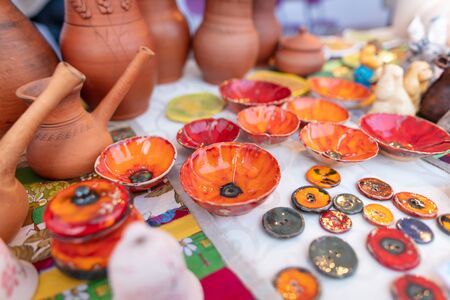Embracing Diversity: The Significance of Colours in Indian Childhood
India, a land renowned for its kaleidoscopic vibrancy, teaches children the language of colours from the very beginning. The hues that paint everyday life—whether in festivals, clothing, or school celebrations—are not mere decoration; they are living symbols of unity and diversity. Children in India grow up surrounded by the energetic reds of Holi, the peaceful whites of Independence Day, and the auspicious yellows of springtime rituals. This rich palette becomes an integral part of their early imagination, shaping how they see themselves and the world around them. From bustling city streets adorned with marigolds to rural homes brightened by rangoli patterns, colours serve as reminders that dreams have many shades and ambitions are limitless. In this way, India’s vibrant culture nurtures a generation ready to dream big—teaching every child that diversity is strength and unity is beauty.
2. Colours and Cultural Celebrations: Inspirations for Growing Minds
India’s vibrant cultural tapestry is deeply interwoven with colours, festivals, and rituals that ignite the imagination of every child. Among the most beloved traditions are Holi and the art of Rangoli—both of which play a crucial role in shaping young minds with positivity, hope, and creative ambition.
The Joyful Spirit of Holi
Holi, known as the ‘Festival of Colours,’ marks the arrival of spring and symbolises victory over negativity. Children across India eagerly await this festival, where they express themselves freely by throwing and smearing gulal (coloured powders) on friends and family. This tradition not only fosters a sense of unity but also encourages children to embrace diversity, learn about their heritage, and nurture aspirations without boundaries.
The Artistic Inspiration of Rangoli
Rangoli is another cherished tradition during major festivals such as Diwali and Onam. Using coloured powders, rice, or flowers, children create intricate patterns at home entrances to welcome prosperity and good fortune. Through Rangoli, kids are introduced to the world of design and geometry while also developing patience, concentration, and an appreciation for aesthetic beauty.
How Festivals Inspire Children’s Dreams
| Festival/Ritual | Colours Used | Inspiration for Children |
|---|---|---|
| Holi | Bright pinks, yellows, blues, greens | Courage to express dreams openly; joy in shared experiences; positive outlook |
| Rangoli | Purple, orange, red, white, yellow (natural powders) | Creativity; patience; sense of accomplishment; love for Indian tradition |
Through these colourful celebrations, Indian children find inspiration to dream big and pursue ambitions with confidence. The playful nature of Holi encourages them to imagine a world without limitations, while Rangoli teaches them that every dream begins with a single dot of colour—growing into beautiful patterns with care and vision. Together, these traditions nurture young hearts to reach new heights in imagination and achievement.

3. Creating Positive Learning Spaces: The Role of Colours in Classrooms
In the vibrant tapestry of India’s educational landscape, the thoughtful selection and use of colours within classrooms play a transformative role in nurturing young minds. Across the country, educators and architects are increasingly recognising how certain shades can foster environments that uplift children’s dreams and ambitions to new heights. By integrating culturally resonant hues, Indian schools are not only creating visually appealing spaces but also promoting focus, energy, and motivation among students.
Enhancing Focus with Calming Tones
Calm shades like light blue and soft green are often chosen for classroom walls to help students feel centred and attentive. These colours, reminiscent of clear skies and lush fields seen across rural India, evoke a sense of peace that supports concentration during lessons. When children enter a classroom imbued with such serenity, their minds become more receptive to learning, allowing their ambitions to flourish naturally.
Energising Young Minds through Vibrant Accents
Indian classrooms are also enlivened by accents of energetic colours like orange, yellow, or magenta—shades deeply rooted in local festivals and traditions. These colours spark enthusiasm, creativity, and a zest for participation. Whether it is a splash of yellow representing positivity or a touch of orange symbolising vibrancy, these hues encourage children to dream boldly and approach challenges with renewed vigour.
Cultural Sensitivity in Colour Choices
The selection of classroom colours is often guided by cultural understanding. For example, green may be used to signify growth and harmony in regions where it holds special meaning, while saffron can inspire courage and spiritual strength. By respecting local traditions and values through colour, schools ensure that every child feels seen, supported, and empowered on their educational journey.
Ultimately, the intentional use of colour in Indian classrooms creates spaces where children’s aspirations soar. When learning environments echo both cultural heritage and psychological well-being, they become sanctuaries for nurturing the next generation’s dreams and ambitions.
4. Colour Psychology: Supporting Emotional and Mental Growth
In India, the wisdom of colours is woven into the very fabric of daily life, from vibrant festivals to sacred rituals and family homes. The science of colour psychology reveals that colours have a profound effect on our emotions and mental well-being—especially for children whose minds are open and sensitive. When thoughtfully chosen, colours can nurture confidence, spark joy, and create emotional stability in growing minds.
The Science Meets Ancient Indian Wisdom
Modern research shows that exposure to different colours can influence mood and behaviour. For example, soft greens foster calmness, while bright yellows stimulate creativity and optimism. This aligns beautifully with ancient Indian philosophies such as Ayurveda and Vastu Shastra, which recognise how specific hues bring harmony to mind, body, and spirit. In many Indian households, rooms are painted according to these principles to ensure positive energy (prana) flows freely, supporting the holistic growth of children.
Impact of Colours on Children: A Practical Guide
| Colour | Emotional Benefit | Ancient Indian Perspective |
|---|---|---|
| Saffron (Kesariya) | Boosts courage and ambition | Symbolises strength and purity in Hindu tradition |
| Green (Hariyali) | Promotes calmness and focus | Associated with healing and balance in Ayurveda |
| Yellow (Haldi) | Sparks joy and positivity | Represents learning and knowledge; used in auspicious ceremonies |
| Blue (Neela) | Brings serenity and trust | Tied to Lord Krishna; evokes spiritual depth and protection |
| Pink (Gulabi) | Nurtures love and kindness | A favoured colour in Indian celebrations for its warmth and harmony |
Cultivating Resilience Through Colourful Spaces
When children live, learn, or play in environments filled with uplifting colours rooted in Indian culture, their confidence grows naturally. These colours become gentle guides—helping them navigate emotions, develop resilience, and express themselves with joy. By blending scientific understanding with time-honoured Indian traditions, we create spaces where children’s dreams soar high on a rainbow of possibilities.
5. Art, Stories, and Folk Traditions: Empowering Ambition Through Creative Expression
The Living Tapestry of Indian Storytelling
From the heart of every Indian home to the vibrant corners of every village, storytelling is more than just a tradition—it is a living bridge connecting generations. Grandparents narrate tales from the Mahabharata or Panchatantra under the shade of neem trees, painting vivid images with their words. These stories are often coloured with lessons of courage, hope, and ambition. For children, each story becomes a canvas where they imagine their own roles—brave princes, wise queens, or clever animals—shaping their dreams in radiant hues that uplift their ambitions.
Folk Art: A Palette for Aspirations
India’s folk art forms like Madhubani from Bihar, Warli from Maharashtra, and Pattachitra from Odisha are not only visually captivating but also deeply symbolic. Each stroke and motif tells a story and expresses an aspiration. When children participate in these creative traditions—whether by helping parents during festive preparations or learning from local artisans—they find a colourful language to express their hopes and ambitions. In these moments, colours become more than pigments; they transform into tools of self-discovery and empowerment.
Family Bonding through Colours
Family plays a central role in nurturing children’s dreams in India. Whether it is decorating homes together during festivals like Diwali or Holi, or painting simple rangolis at the doorstep each morning, colour becomes a medium for connection and shared joy. Parents encourage children to use bold reds for passion, soothing greens for harmony, or bright yellows for optimism—each choice reflecting a unique aspiration. Through this bonding, families create a safe space where ambitions are cherished and encouraged to soar high.
Colours as Vessels of Cultural Wisdom
In Indian culture, every hue carries meaning and significance. Children learn that saffron stands for strength, blue evokes wisdom, and pink symbolises compassion. As they listen to folk tales or participate in age-old rituals, colours help them internalise values and visualise futures filled with possibilities. The blending of stories, art, and family traditions thus becomes a powerful force that uplifts children’s dreams and ambitions to new heights—a beautiful symphony where creativity knows no limits.
6. Nurturing Future Leaders: How Communities Can Uplift Young Aspirations
Creating Environments That Inspire Growth
In India’s vibrant social fabric, colours are woven into daily life, from the playful rangolis at doorsteps to the colourful uniforms in schools. When families, educators, and communities intentionally bring colour into children’s lives, they spark hope, cultivate ambition, and nurture dreams that reach beyond the ordinary. By choosing uplifting hues in learning spaces and homes—such as energising saffron, calming greens, and joyful yellows—we set the stage for children to envision brighter futures.
Families: Bringing Colours Home
Parents can thoughtfully decorate children’s rooms with positive colours like yellow for cheerfulness or green for harmony. Involving children in picking wall colours or artwork not only creates a sense of belonging but also encourages self-expression and confidence. Simple traditions like celebrating festivals with coloured powders or dressing up in vibrant attire allow children to feel connected to their roots while embracing optimism and creativity.
Educators: Colourful Classrooms of Possibility
Teachers can use colourful teaching aids and classroom décor to make learning engaging and memorable. Incorporating traditional Indian motifs and hues—such as peacock blues or marigold oranges—can help students connect with cultural pride while stimulating imagination. Activities like art projects with natural dyes or classroom murals depicting dreams foster teamwork, vision, and a sense of achievement among young learners.
Communities: Public Spaces that Spark Inspiration
Community leaders can revitalise parks, libraries, and community centres using bold colours inspired by India’s festivals and nature. Murals featuring local heroes or stories painted in lively shades remind children of what’s possible when ambition is supported collectively. Organising art competitions or Holi-inspired colour events helps children dream bigger by creating a shared atmosphere of positivity and hope.
Cultivating Ambition Together
When every part of a child’s environment—from home corners to school corridors to public playgrounds—is consciously imbued with colours that uplift, we empower the next generation to dream fearlessly. By working together as families, educators, and communities, we nurture not only future leaders but also compassionate visionaries who will paint India’s tomorrow with courage, joy, and boundless possibility.

